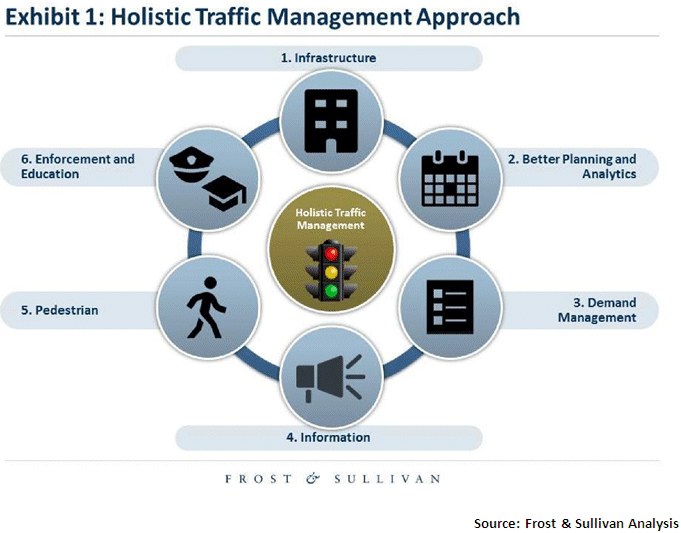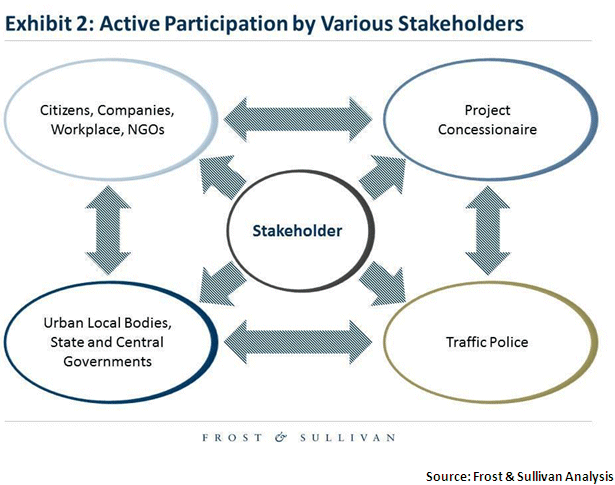By Kavan Mukhtyar, Senior Partner, Smart Cities Practice, Frost & Sullivan
Worsening Traffic Congestion is Affecting Our Lives
Rapid urbanization coupled with growing economic prosperity is making our cities very congested. With easy availability of finance, number of vehicles on road is increasing sharply. However, roads are not being built and upgraded fast enough to keep pace with the growth in vehicles. Public transportation investments are a possible solution, but these projects have long implementation horizons. Worsening road traffic congestion is affecting quality of life, productivity, and competitiveness of our cities. This urban issue is more acute in metropolitan cities, which are also the economic nerve centers of the country. As we embark on making our cities smart, addressing the traffic congestion issue should assume high priority. This can unlock huge economic savings and improve livability of our cities.
A Holistic Traffic Management Approach is Necessary for a Sustainable Solution
City and traffic management authorities have implemented numerous projects to improve traffic flow. This includes intelligent traffic management systems, bus rapid transportation system, rail and road widening, and flyovers. These measures have seen varied levels of success.
Globally, Smart Transportation Solutions are being implemented to optimize traffic flows. However, India has its own unique characteristics and challenges. For example, issues relating to rampant traffic rule violations, pedestrian management, encroachments, event-based disruptions, and basic infrastructure constraints need to be managed. Smart transportation solutions need to be rigorously localized to make them a success. A holistic and multi-pronged traffic management approach is necessary for a practical solution that works in the Indian context.
Exhibit 1 shows Frost & Sullivan’s recommended approach for holistic traffic management.

1. Infrastructure Investments: Operational capacity of the roads needs to be increased to keep pace with the demand. Additionally, as our cities grow, new transportation patterns evolve. Infrastructure investments should be made with a long-term city master plan in mind. The benefits of infrastructure investments can be realized only in the long term. A cursory study of traffic patterns in major cities shows that junctions are the hot spots of traffic congestion. Focused efforts should be made to streamline traffic flow at junctions of arterial roads. It can be through a combination of efforts including superior road quality at junctions, road upgrade, widening, clear road markings and so on.
2. Better Transportation Planning and Analytics: The core reason for traffic congestion is that our urban master planning has been flawed and short sighted. With the emphasis on developing smart city plans, governments have a fresh opportunity to take a long range view of traffic management. Several technology solutions can provide deep transportation analytics capabilities. There is also an urgent need to bring specialized transportation management capabilities to the cities.
3. Better Demand Management through Community Participation: Peak time road demand can be managed through community and workplace participation. Globally, many cities have staggered work timings as well as introduced congestion fee to manage peak demand.
4. Traffic Information Management to Optimize Traffic Flow: Real time traffic information can be developed through multiple inputs including:
- Traffic cameras and sensors
- Crowd sourcing from commuters
- Manual on-the-ground monitoring and inputs
- Smart applications
- Cellular information and global positioning systems
- Aerial monitoring
These inputs should be visible at a city-wide traffic command and control room. Traffic management authorities can be supported by predictive traffic optimizing tools to drive effective decisions. This can form the basis for communicating location-based traffic advisories for the commuters. Cost-effective media such as radio broadcast, electronic signage, traffic portals, SMS, or traffic optimizing applications should be promoted. Special emphasis should be laid on strengthening traffic response capabilities for unplanned incidents. This is typically triggered by vehicle breakdown, accidents, or other unexpected episodes. Maintenance, repair work, or traffic congestion triggered by planned events should be pre-empted and mitigation strategies should be implemented.
5. Pedestrian Management: Most major Indian cities have no mechanism of managing high volume pedestrian traffic. In many instances, with no separate pedestrian ways, this traffic converges with the vehicular traffic. This causes serious safety hazards as well as slowing of traffic movement. Deploying wardens at crucial junctions to manage pedestrian traffic can be an effective approach. In the long term, investments in sky walks, separate foot paths, and pedestrian fencing at the median and side of the road will reduce disruptions of vehicle flow and improve pedestrian safety. Highly congested cross-over points for multi-modal transportation such as railway stations, bus stations, markets, and shopping malls should be mandated to plan for uninterrupted pedestrian ways.
6. Enforcement and Education: In general, enforcement of traffic laws in India is much below global standards. A concerted effort must be made to increase the enforcement standards through strict penalties and demerits on the license. Technology should be leveraged to prosecute traffic violators with minimum human intervention. As the deployment of CCTV cameras grows within our cities, it can easily be leveraged for traffic enforcement. A strong political conviction will be necessary to implement such measures. Concerted efforts need to be made to educate all the stakeholders to improve the traffic situation in our cities. Driving license certification levels should be raised. Driving simulation training should be encouraged. Pedestrians should be educated about their rights and duties to ensure their safety and minimize traffic disruption. The traffic management authorities must also invest in capability building of their field staff, especially for leveraging emerging technologies.
Smart Solutions should Aim to Balance Road Demand with Capacity to Optimize Traffic Flow
Leveraging the above framework, smart traffic solutions should aim to deliver efficiency along two action streams:
- Demand [Road users] management
- Supply [Road infrastructure] management
Demand management strategies can be developed through on-the-ground traffic surveys and citizen participation. Some possible ideas to consider are:
- Building an online community for voluntary staggered workplace timings to reduce peak time vehicles on road
- Encouraging Multi-modal networks with preference for public transportation
- Encouraging open source traffic information by promoting online applications that advise vehicle users on optimum traffic route options; promoting such applications through social media
- Ensuring roadside electronic traffic advisory to re-channelize traffic to avoid blocked roads where possible
Supply management can focus on initiating various steps including using Information & Communication Technologies to improve traffic throughputs. The following steps can be implemented:
- Online e-portal deployment for better inter-departmental coordination and planning for repair and maintenance works, especially at junctions. Such activities should be permitted only during off-peak hours and disruption time should be minimized.
- Parking guidance information is to be provided as well as separate parking zones are to be built to avoid traffic slowdown, especially at office areas.
- Enhancing the quality of roads at junctions, and ensuring road marking, road widening, as well as encroachment removal.
- Over bridge pedestrian crossings at key junctions are to be constructed and flow regulation is to be maintained.
- Dynamic road dividers to channelize traffic flow depending on the peak time demand changes are to be built.
- The emergency response team is to be formed.
- Leveraging technology for debottlenecking is to be implemented.
Traffic Management Needs to Be a Collective Responsibility for Optimum Results
Traffic management is generally perceived as the sole responsibility of the traffic police. However, a broader perspective is necessary.
As shown in Exhibit 2, a holistic approach with active participation by governments of
the city, state, along with the traffic police is necessary. Many cities around the world such as Singapore and Kuala Lumpur have fully empowered land transport authorities with specialized skills for transport planning, research, asset management, maintenance, and optimization.

Active citizen participation through workplace, companies, and NGOs can deliver positive results. Citizens should be made partners in improving traffic conditions through education and incorporating community suggestions.
Private sector participation can bring in expertize, resources, and latest technologies to help solve this key urban challenge. Urban local bodies can identify specific project components for private sector participation in traffic management. There could be various models of funding based on the level of engagement. Latest thinking is to tie-in project concessionaire performance levels through service level agreements. Public private partnership funding models can be developed to attract the right private sector partners.
Smart Traffic Solutions Can Make a Difference
ICT-enabled smart traffic solutions have a strong potential to make a difference in solving traffic congestion problems. However, these solutions should be carefully adapted to each city’s unique characteristics and transport legacy. A holistic and long-term approach is necessary to fully avail the benefits of the technology interventions. Learnings and best practices from other developing countries can be a good starting point. Eventually, India will evolve its own model of solving traffic congestion challenges by leveraging smart technologies to improve the livability of our cities.



